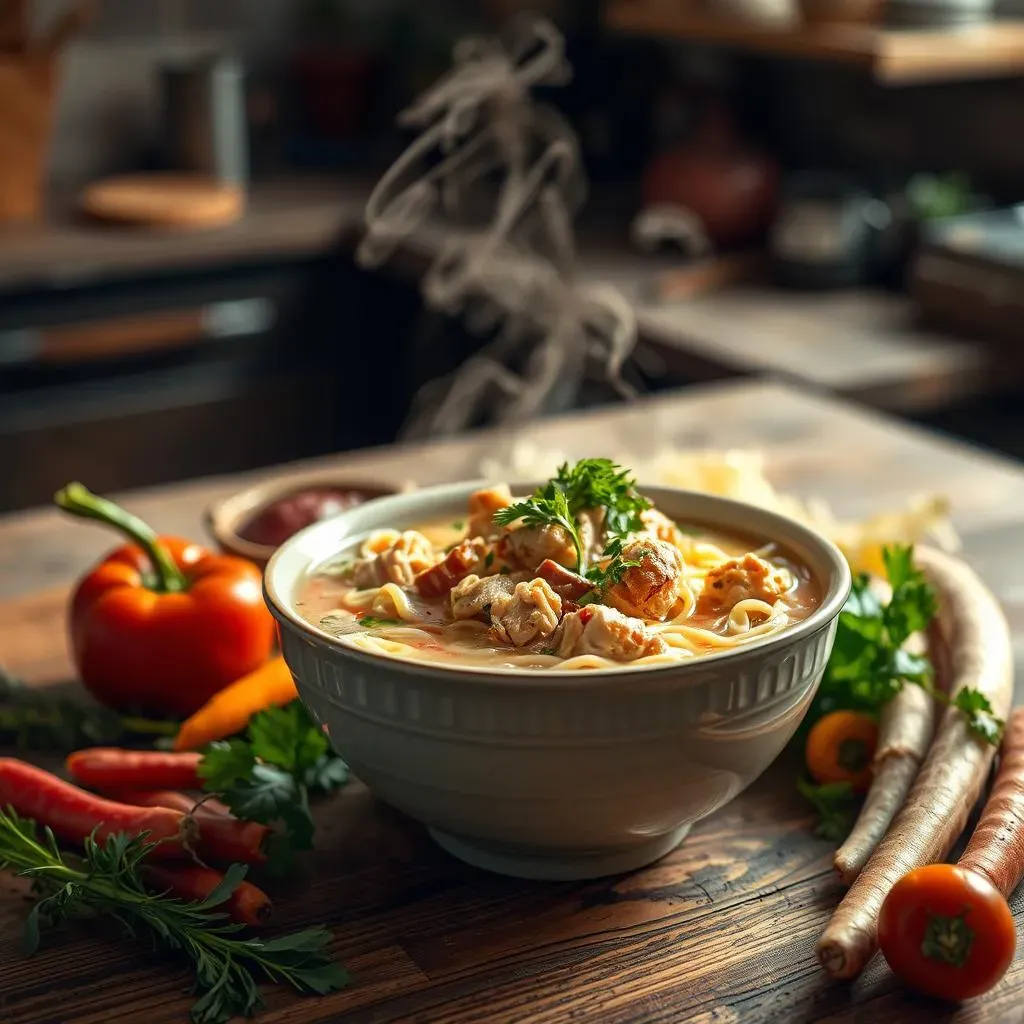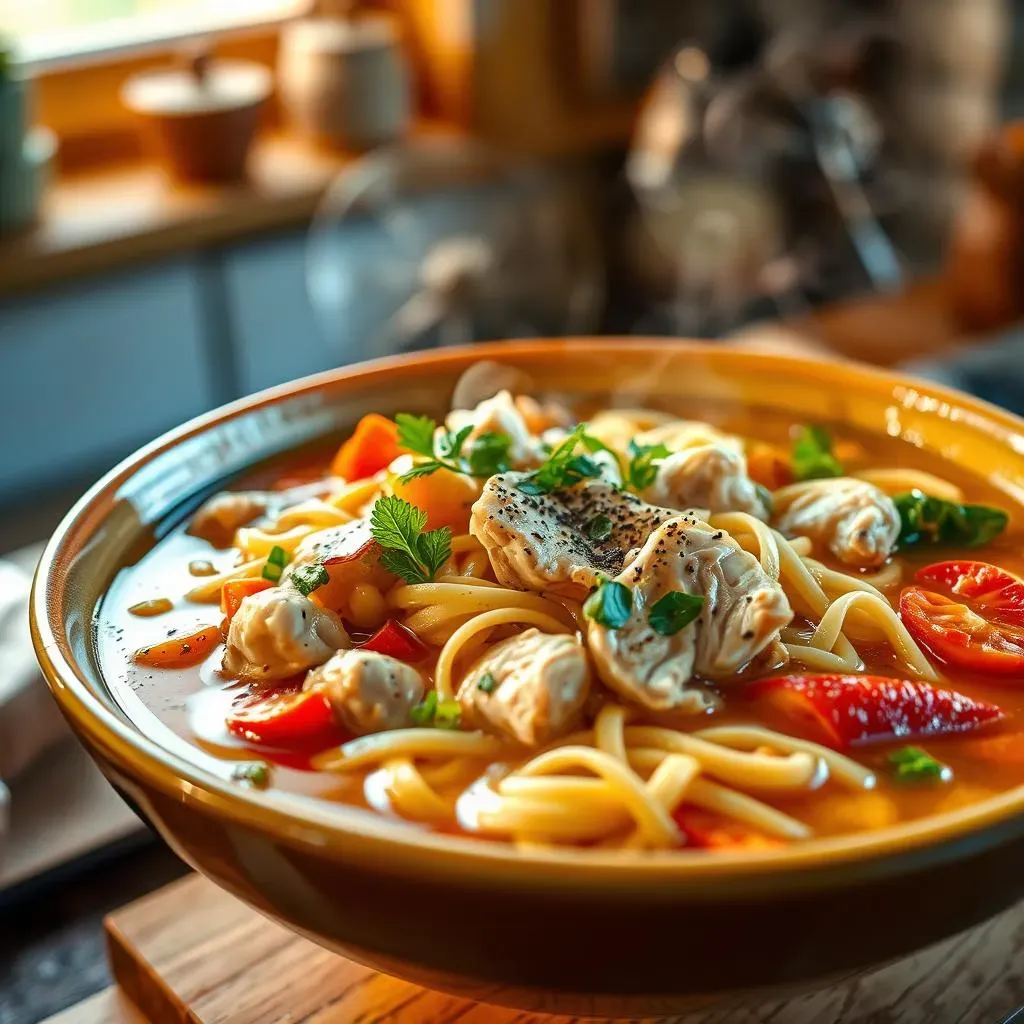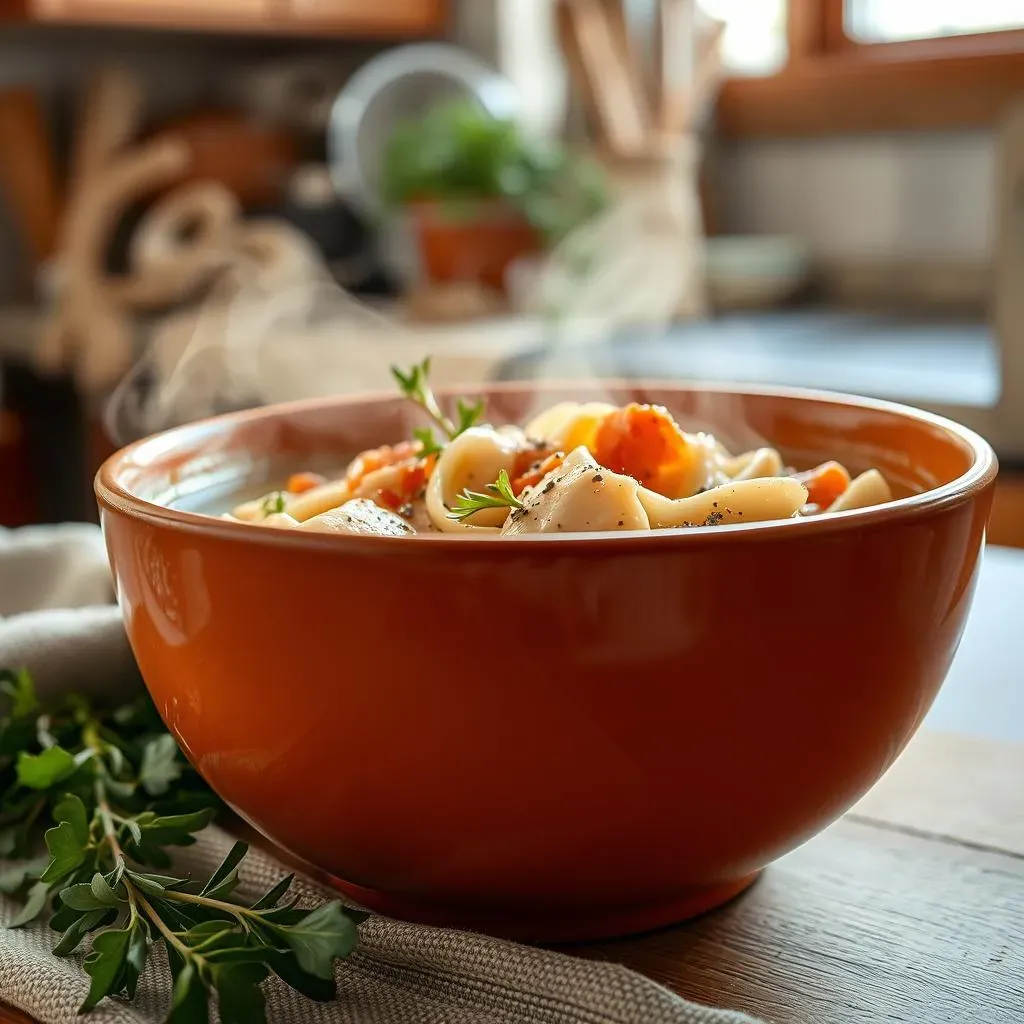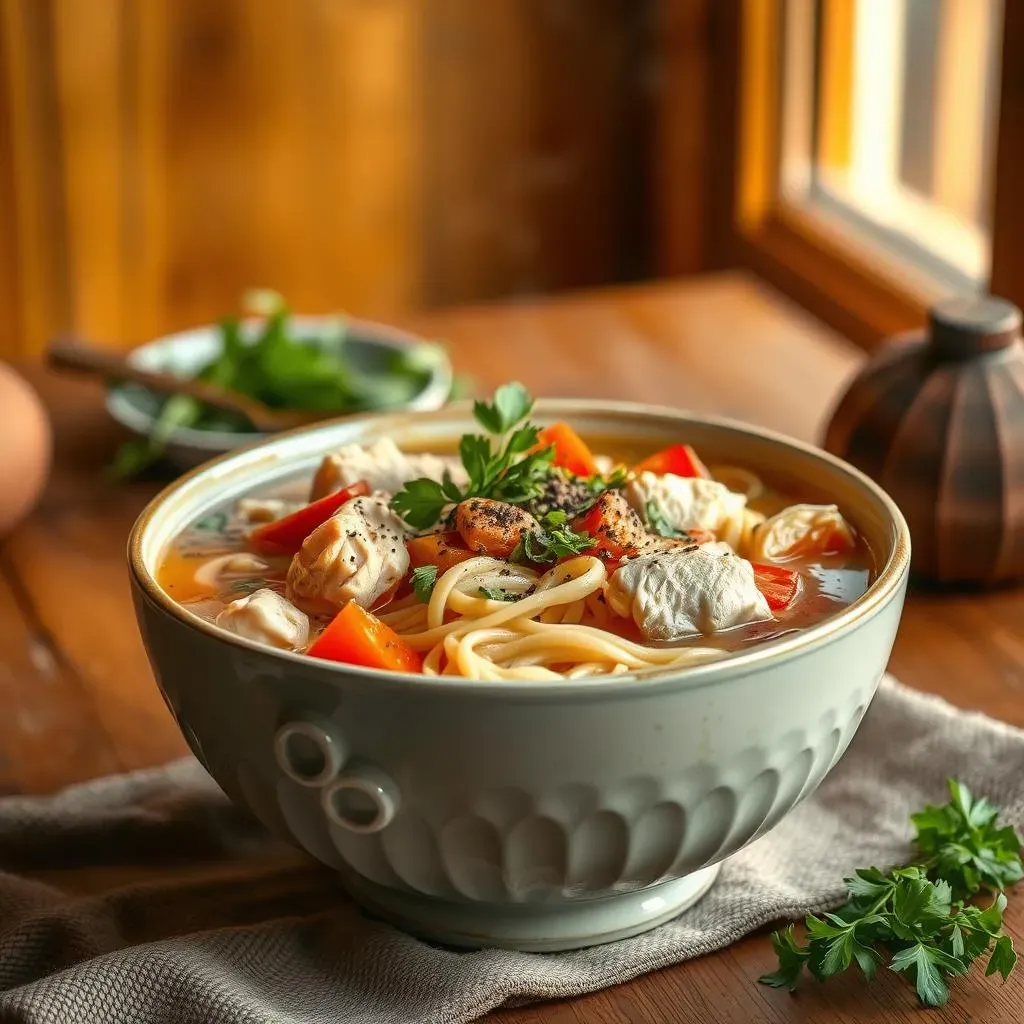Table of Contents
Is there anything quite as comforting as a warm bowl of chicken noodle soup? Especially when you're feeling under the weather, or simply craving a taste of home. But let's be honest, not all chicken noodle soups are created equal. We're not talking about the bland, watery stuff from a can. This is about crafting a truly flavorful chicken noodle soup recipe that's packed with deliciousness and made with love.
Unlock the Secrets to a Flavorful Chicken Noodle Soup Recipe

Unlock the Secrets to a Flavorful Chicken Noodle Soup Recipe
The Broth is Boss
Let's face it, the broth is the heart and soul of any good chicken noodle soup. It's where all that comforting flavor comes from. You can't just throw some water and bouillon cubes in a pot and expect magic to happen. A truly flavorful broth requires a bit more finesse, and a little patience. The secret? Homemade stock. Trust me, the difference is night and day.
Making your own chicken stock might sound intimidating, but it's actually surprisingly easy. All you need is a whole chicken (or chicken pieces like backs and necks – great for flavor!), some vegetables (onion, carrots, celery are the classics), herbs (bay leaf, thyme, parsley), and water. Simmer it all together for a few hours, and you'll be rewarded with a rich, golden elixir that will transform your soup. Don't have time to make your own stock? Don't worry! Opt for a high-quality store-bought broth, preferably low-sodium, and doctor it up with some extra herbs and spices.
The Right Bird Makes All the Difference
Now, let's talk chicken. The type of chicken you use will significantly impact the flavor of your soup. While rotisserie chicken is a convenient option (and we'll get to that in a minute), using bone-in, skin-on chicken pieces is the way to go for maximum flavor. Think chicken thighs or a whole chicken cut into pieces. The bones add richness to the broth, and the skin adds depth of flavor.
If you are short on time, using rotisserie chicken is OK. But, make sure to find a good quality rotisserie chicken for the best flavor. Shred or dice the chicken and add it to the soup later in the cooking process to prevent it from drying out.
Chicken Options
- Bone-in, skin-on chicken pieces: Best for flavor
- Rotisserie chicken: Convenient, but less flavorful
- Chicken breasts: Lean, but can be dry if overcooked
Veggies: The Flavor Foundation
Don't underestimate the power of vegetables! Onions, carrots, and celery (also known as mirepoix) are the holy trinity of soup making. Sautéing them in a little butter or olive oil before adding the broth helps to develop their sweetness and create a flavorful base for the soup. But don't stop there! Consider adding other vegetables like garlic, leeks, mushrooms, or even a touch of ginger for an extra layer of complexity.
The key is to cook the vegetables until they're tender but not mushy. You want them to retain their texture and flavor, so they add a pleasant bite to each spoonful of soup. Adding some mushrooms can add a depth of umami to the soup. You can play around with different vegetables, but be sure to add them in a way that each vegetable compliment each other.
Also, consider dicing the vegetables into uniform sizes to ensure even cooking and a visually appealing soup.
Building Blocks of Flavor: Key Ingredients for Chicken Noodle Soup

Building Blocks of Flavor: Key Ingredients for Chicken Noodle Soup
Noodles: Choosing the Right Shape and Texture
Let's be real, what's chicken noodle soup without the noodles? It's just... chicken soup. But not all noodles are created equal. The type of noodle you choose can significantly impact the overall texture and enjoyment of your soup. Egg noodles are the classic choice, and for good reason. They're rich, tender, and hold their shape well in the broth. But don't be afraid to experiment!
Try using other types of pasta like ditalini, orzo, or even broken spaghetti. Just keep in mind that different noodles will cook at different rates, so adjust the cooking time accordingly. Also, for gluten-free friends, there are many great gluten-free noodles out there that work just as well.
I like to add my noodles during the last 15 minutes of cooking. This will help you avoid mushy noodles.
Herbs and Spices: Adding Depth and Complexity
This is where you can really get creative and customize your flavorful chicken noodle soup recipe to your liking. Fresh herbs like parsley, thyme, and dill can add a bright, vibrant flavor to the soup. Dried herbs like bay leaf, oregano, and rosemary can add a more subtle, earthy note. Don't be afraid to experiment with different combinations to find your perfect blend. A pinch of red pepper flakes can add a touch of heat, while a squeeze of lemon juice can brighten up the flavors and add a zesty kick.
I'm a big fan of adding a bay leaf or two to the soup while it simmers. It adds a subtle, almost indescribable depth of flavor that really elevates the dish. Just remember to remove it before serving!
Seasoning: Salt, Pepper, and Beyond
Salt and pepper are essential, of course, but don't be afraid to go beyond the basics. Taste your soup frequently throughout the cooking process and adjust the seasoning as needed. A little bit of salt can go a long way in bringing out the flavors of the other ingredients. If your soup tastes flat, try adding a pinch of MSG (yes, really!). It's a flavor enhancer that can add a savory, umami note. Other options include soy sauce, fish sauce, or even a splash of Worcestershire sauce.
Remember, you can always add more seasoning, but you can't take it away! Start with a small amount and gradually increase until you reach your desired level of flavor.
Ingredient | Purpose | Notes |
|---|---|---|
Salt | Enhances flavor | Add gradually, taste frequently |
Pepper | Adds spice and complexity | Use freshly ground for best flavor |
MSG | Enhances umami | Use sparingly |
StepbyStep: Crafting Your Flavorful Chicken Noodle Soup

StepbyStep: Crafting Your Flavorful Chicken Noodle Soup
Prep Like a Pro: Mise en Place
Before you even think about turning on the stove, take a deep breath and get organized. This is the "mise en place" – a fancy French term for having everything in its place. Chop your vegetables, measure out your spices, and have your chicken ready to go. This will make the cooking process so much smoother and more enjoyable. Trust me, there's nothing worse than scrambling to chop an onion while your broth is simmering away.
It may seem tedious, but taking the time to prep your ingredients beforehand will allow you to focus on the cooking process and ensure that everything cooks evenly. Plus, it's just more relaxing when you're not rushing around like a headless chicken (pun intended!).
So, roll up your sleeves, put on some music, and get chopping! Your future self will thank you.
Simmer, Don't Boil: The Art of Broth Making
Whether you're using homemade or store-bought broth, the key is to simmer it gently. Boiling your broth will result in a cloudy, less flavorful soup. Aim for a gentle simmer, where you see small bubbles rising to the surface. This will allow the flavors to meld together beautifully without making the broth bitter. If you're using bone-in chicken, simmer it in the broth for at least an hour, or even longer, until the chicken is cooked through and tender. Then, remove the chicken from the pot and shred or dice it.
Also, skimming off any scum that rises to the surface of the broth will help to create a clearer, more flavorful soup. Don't be afraid to add extra herbs and spices to the broth while it simmers. This is your chance to really customize the flavor to your liking.
Remember, patience is a virtue when it comes to broth making. The longer you simmer it, the more flavorful it will be.
Noodle Nirvana: Timing is Everything
As I mentioned before, timing is crucial when it comes to adding the noodles. Nobody likes mushy noodles! Add them to the soup during the last 10-15 minutes of cooking, or until they're tender but still have a slight bite. The exact cooking time will depend on the type of noodle you're using, so be sure to check the package instructions.
If you're making a big batch of soup and plan on storing leftovers, it's best to cook the noodles separately and add them to each serving as needed. This will prevent them from soaking up all the broth and becoming mushy in the fridge. Nobody wants that, so be sure to follow this tip and save the soup from becoming a mushy mess.
Also, be sure to stir the soup occasionally while the noodles are cooking to prevent them from sticking together.
Noodle Type | Cooking Time (approx.) | Notes |
|---|---|---|
Egg Noodles | 8-10 minutes | Classic choice |
Ditalini | 10-12 minutes | Small and delicate |
Orzo | 8-10 minutes | Rice-shaped pasta |
Beyond the Basics: Elevating Your Homemade Chicken Noodle Soup Recipe

Beyond the Basics: Elevating Your Homemade Chicken Noodle Soup Recipe
Adding a Touch of Creaminess
Want to take your soup to the next level of indulgence? Try adding a touch of creaminess. A swirl of heavy cream, half-and-half, or even coconut milk can add a luxurious richness to the soup. Be careful not to add too much, though, or it will become overly heavy. A little goes a long way! For a lighter option, try stirring in a spoonful of Greek yogurt or sour cream just before serving. It will add a tangy creaminess without all the extra fat.
For dairy-free friends, pureed cashews can be a great option. It will provide a nutty flavor, and a creamy texture without the need for dairy.
Lemon Zest: A Brightening Boost
A little bit of lemon zest can do wonders for brightening up the flavors of your soup. The acidity of the lemon cuts through the richness of the broth and adds a zesty kick that will wake up your taste buds. Just be sure to use only the zest, not the pith (the white part), as the pith can be bitter. A microplane is the perfect tool for zesting lemons. If you don't have one, you can use a vegetable peeler to remove strips of zest and then mince them finely.
Also, consider adding a squeeze of fresh lemon juice to the soup just before serving for an extra burst of flavor.
I have been making chicken noodle soup for years, and adding a little bit of lemon is my secret ingredient. It is a game changer, and will make your chicken noodle soup stand out.
Spice It Up: Adding a Kick
If you're feeling adventurous, why not add a little bit of spice to your flavorful chicken noodle soup recipe? A pinch of red pepper flakes, a dash of hot sauce, or even a finely chopped jalapeño can add a pleasant warmth to the soup. If you're using jalapeños, be sure to remove the seeds and membranes for a milder flavor. For a more complex heat, try adding a teaspoon of curry powder or a splash of sriracha. Just remember to start with a small amount and gradually increase until you reach your desired level of spiciness.
Spice | Flavor Profile | Notes |
|---|---|---|
Red Pepper Flakes | Dry, slightly fruity heat | Add a pinch for a subtle warmth |
Hot Sauce | Vinegary, spicy | Choose your favorite brand |
Jalapeño | Fresh, grassy heat | Remove seeds for milder flavor |
Flavorful Chicken Noodle Soup: Tips, Tricks, and Variations

Flavorful Chicken Noodle Soup: Tips, Tricks, and Variations
Storage Secrets: Keeping Your Soup Fresh
so you've made a big batch of this amazing flavorful chicken noodle soup recipe, but you can't possibly eat it all in one sitting. No problem! Chicken noodle soup stores beautifully in the refrigerator for up to 3-4 days. Just make sure to let it cool completely before transferring it to an airtight container. As I mentioned before, if you're planning on storing leftovers, it's best to cook the noodles separately and add them to each serving as needed. This will prevent them from becoming mushy in the fridge and ruining your soup experience. Nobody wants sad, soggy noodles!
For longer storage, you can also freeze chicken noodle soup. However, the texture of the noodles may change slightly after freezing and thawing. To minimize this, undercook the noodles slightly before adding them to the soup. Also, consider freezing the soup in individual portions for easy thawing and reheating.
Make-Ahead Magic: Soup Prep Like a Boss
Want to get ahead of the game? You can easily prep many of the components of this flavorful chicken noodle soup recipe in advance. Chop your vegetables, make your broth, and even cook your chicken a day or two ahead of time. Store everything in separate containers in the refrigerator, and then simply combine them when you're ready to make the soup. This is a great option for busy weeknights when you don't have a lot of time to cook. Simply combine all the ingredients, and you will have a delicious, home-cooked meal in no time.
Also, consider making a big batch of chicken stock on the weekend and freezing it in portions. This way, you'll always have homemade stock on hand for making soup or other dishes.
I have been making chicken noodle soup for years, and prepping the ingredients in advance is a game changer. It saves me so much time and stress during the week.
Component | Make-Ahead Tip |
|---|---|
Vegetables | Chop and store in an airtight container |
Broth | Make and store in the refrigerator or freezer |
Chicken | Cook, shred, and store in the refrigerator |
Flavor Variations: Customize Your Soup
The beauty of chicken noodle soup is that it's incredibly versatile and easy to customize to your liking. Feel free to experiment with different vegetables, herbs, and spices to create your own unique flavor profile. For a Mexican-inspired twist, try adding some corn, black beans, and a pinch of chili powder. For a creamy version, stir in a dollop of sour cream or Greek yogurt just before serving. Or, for a lemon-herb version, add a squeeze of fresh lemon juice and a sprinkle of fresh dill.
Don't be afraid to get creative and have fun with it! The possibilities are endless.
- Mexican-inspired: Corn, black beans, chili powder
- Creamy: Sour cream or Greek yogurt
- Lemon-herb: Lemon juice and fresh dill
The Last Sip: Enjoying Your Flavorful Chicken Noodle Soup
There you have it – your very own flavorful chicken noodle soup recipe! This isn't just a meal; it's a hug in a bowl, a remedy for the soul, and a testament to the magic that happens when simple ingredients come together with a little bit of love and attention. Whether you stick to the classic recipe or get adventurous with the variations, we hope this guide inspires you to create countless bowls of comfort for yourself and those you care about. So, grab a spoon, savor each spoonful, and remember that the best meals are often the ones made from scratch.
